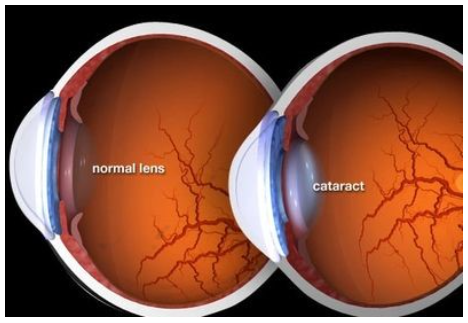
Cataracts are one of the leading causes of vision loss in the United States. They are extremely common among older adults— About one in six Americans aged 40 and older will get a cataract, and more than half will get them by the time they are 80 years old. But younger people, even babies, can develop cataracts too, though it is much rarer.
Yet despite the prevalence of cataracts, many people are unaware of the symptoms and are not sure what they can do if they get them.
What Are Cataracts?
A cataract is a clouding of the lens that sits behind the iris, which is the colored part of the eye. The lens’s job is to focus the light that passes into your eye. The lenses in your eyes are usually clear, but with age and certain other medical conditions, they get thicker and less transparent. Over time, proteins and fibers within the lens can break down and clump together, making the lens cloudy. Once a cataract forms, it scatters and blocks light as it passes through the lens, resulting in hazy or blurry vision. Cataracts tend to develop slowly, and a person with newly forming cataracts may not notice anything at first. But eventually, cataracts usually affect vision enough to interfere with the ability to do daily tasks.
Cataract Symptoms
These are the most common signs that you may be developing cataracts:
- Clouded, blurred or dim vision
- Worsening night vision
- Sensitivity to light and glare
- A need for brighter light for reading
- Appearance of “halos” around lights
- Fading colors
The cloudiness caused by a cataract may initially affect only a small part of the lens. But as the cataract grows larger, it distorts more of the light passing through, making the symptoms more noticeable.
What to Do if You Experience Symptoms
The first thing to do if you notice any of these changes in your vision is to make an appointment with your eye doctor. “The symptoms are similar to other eye diseases, so it’s important to see the doctor and get an accurate diagnosis any time your vision changes,” says Amy Wurf, Education & Vision Services Director at the Council. Surgery is currently the only treatment available for cataracts, and it is highly effective at restoring vision for most patients. Your doctor will work with you to weigh the benefits, risks and timing of cataract surgery. Amy, a Certified Low Vision Therapist, says that after surgery, most people notice a great improvement in color vision and clarity.
“A lot of people don’t realize how much the cataract was affecting their vision until after the surgery,” Amy says. “They tell us they didn’t realize that colors had gotten so dim. They didn’t realize their kitchen wasn’t covered in yellow wallpaper. They didn’t realize how brightly colored things actually are.”
Most people choose to put off surgery until the cataracts are interfering significantly with daily activities like reading and nighttime driving. In general, delaying surgery won’t affect your recovery or cause permanent damage. But there can be risks involved with waiting too long, since very large, thick cataracts can be more difficult to remove. And of course EVERY type of surgery brings a certain amount risk of infection or other complications.
One risk you do NOT have to worry about is that cataract surgery will cause macular degeneration, as some people believe. Some patients may feel their vision is worse than it used to be after cataract surgery, and they become convinced that the surgery caused the problem. According to Amy, “In those instances, it is much more likely that the surgery merely uncovered another condition that was already present but was obscured by the cataract, which was preventing the eye doctor from getting a clear view of the retina.”
What Else You Can Do
If cataracts are affecting your vision but you are not planning surgery right away, there are several other things you can do to enhance your ability to accomplish daily tasks. For example, if you are having trouble with things like reading medicine bottles or mail, the Council may be able to help.
“There are ways to get around it until you need or are able to get surgery,” Amy says. “Much of that is lighting, magnification and glare control.” Amy notes that the Sharper Vision Store carries many different types of magnifiers, lamps, sunglasses and other aids that can help. “A low vision evaluation, one of the services the Council provides, can help identify the tools and strategies most likely to work for you.”
Lower Your Risk
Nobody knows exactly what causes cataracts. Much of it is just a natural result of aging. But there are several other health factors believed to increase your chances of getting cataracts:
- Diabetes
- Excessive exposure to sunlight
- Smoking
- Obesity
- High blood pressure
- Previous eye injury or inflammation
- Previous eye surgery
- Prolonged use of corticosteroid medications
- Excessive alcohol consumption
While there is no proven way to prevent cataracts, there are several ways most doctors believe you can reduce your risk:
- Get regular eye exams.
- Quit smoking.
- Eat a healthy diet with a lot of fruit and vegetables.
- Wear sunglasses.
- Reduce alcohol intake.
Amy says the reality is that most older adults are going to get a cataract eventually, so it’s important to have regular eye exams. Good information and an early diagnosis, whether for cataracts or another eye condition, will give you the most options and the best chance for successful treatment.

